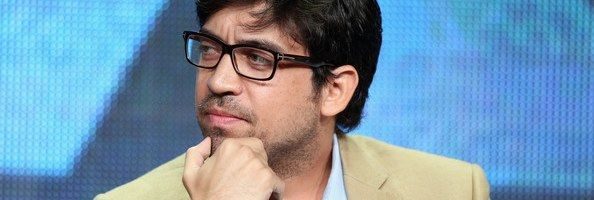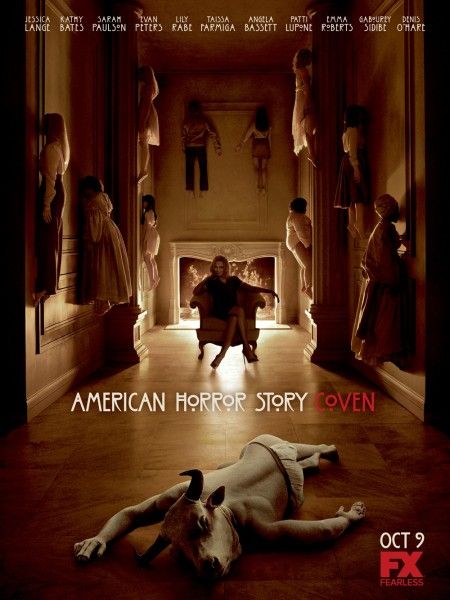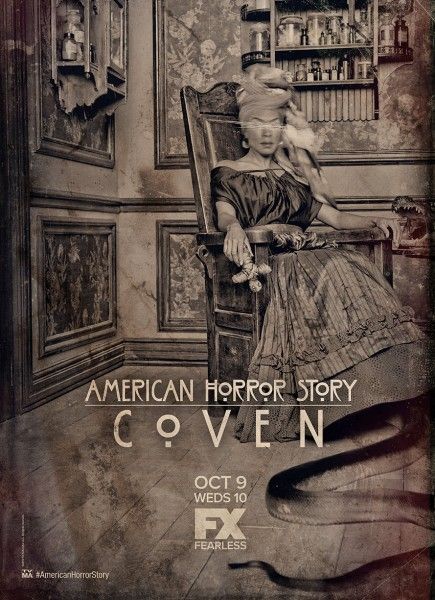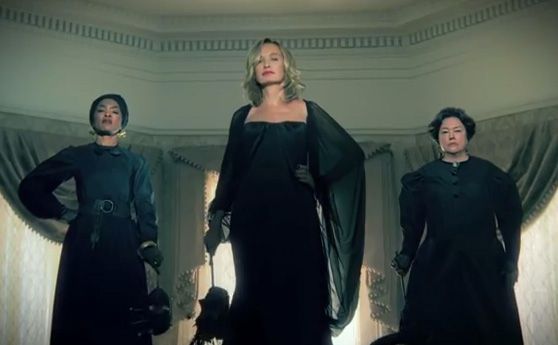From co-creators Ryan Murphy and Brad Falchuk, the FX series American Horror Story uses a unique and compelling approach to television, with a different setting, different characters and a rotating cast of actors for each season. For Season 3, American Horror Story: Coven tells the secret history of witches and witchcraft in America, with a cast of powerhouse actresses that includes Jessica Lange, Kathy Bates, Angela Bassett, Patti LuPone, Sarah Paulson and Frances Conroy.
During this recent exclusive interview with Collider, executive producer/director Alfonso Gomez-Rejon talked about his path to becoming a director, how he came to be working with Ryan Murphy, the natural progression of his career, from episodic director to producing director to feature director, how much more involved he is with American Horror Story this season, how The Town That Dreaded Sundown became his first feature directing job, his unique visual style, and that he’d like to maintain a balance of television and film projects. Check out what he had to say after the jump.
Collider: You started off doing episodes for Glee, and then moved on to American Horror Story. How did you start working with Ryan Murphy?
ALFONSO GOMEZ-REJON: I’m really grateful to Ryan Murphy for so much because he’s fearless. He’s so confident. He has a very unusual and unique way of seeing the world sometimes, and he’s somehow able to translate that into entertainment for the masses, at the right time in pop culture. I think when he recognizes talent, whether arguably I have it or not, he has a way of just nurturing it. The Ryan Murphy television world has assistants who have become producers and writers and. If he trusts you and you have a unique way of seeing his world, he nurtures you. I can’t say enough about him. He just gives new people a shot, and it takes a lot of confidence and generosity to do that.
How did you initially make the step into directing?
GOMEZ-REJON: I’ve been clawing my way to directing since I was a kid. I started in the P.A. world and craft service and storyboard artist, with the eye on the prize of directing. When I was directing second unit on Babel, I ended up casting most of the unknown parts. In these weird circles, I was this guy who found these kids on the streets. I got introduced to Ryan because he was having trouble casting the Balinese section of Eat Pray Love because he wanted real people and wasn’t getting it, and he heard about me because I was that guy.
So, I got a call and I met with him for five minutes. I went out to Bali, and I cast all of these supporting roles. I love that stuff. I just love actors. And then, he asked me to direct second unit for him on Eat Pray Love. I was already booked on something else, but I joined them later. And then, I wrote him a thank you email and I got no response. I was like, “Okay, that’s it.” We didn’t interact much on set either. I was doing my thing. He didn’t even know me, but he was very specific about what he wanted and I would interpret what he said. I didn’t get a reply, but then, all of a sudden, I got an email out of the blue that said, “Do you want to direct an episode of Glee?” I guess it took time for him to see my footage cut together.
So, he sent me the script. TV is all new to me because I came from features. We sat down and I had my first tone meeting. At that point, I had storyboarded every framed and I had a book of boards, which is the feature side of me. It was all very structured. But, he didn’t even want to look at them. He said, “I trust you. Do whatever you want. If anyone tells you that you can’t do something, just tell them that I want it.” He basically said to lie to them, but I never had to use the line. And I don’t think he showed up on set once. That was my first “directed by” credit that wasn’t second unit or an assistant to someone else, and it takes a lot for someone to do that, and have faith in you and follow through with it. So, that episode worked out and I’ve been a part of his family ever since.
Has it felt like a natural progression to go from Glee to American Horror Story, and then becoming a producing director for Coven, and even doing a feature film with together, with The Town That Dreaded Sundown?
GOMEZ-REJON: It does, but I try not to think about it too much. On some kind of unspoken, deep, deep level, I think we have an aesthetic that we both understand or connect to. It’s not that we see the world in the same way because we have very different points of view, but we’re both visual stylists. He has an aesthetic that I really appreciate, and I think he appreciates mine. I was attracted to Glee and thought I could do it because it was an unusual TV show for me, as a viewer. I love visual stylists like Bob Fosse and Vincente Minnelli and Michael Powell & Emeric Pressburger with The Red Shoes and The Tales of Hoffman, and I thought I could bring that to it.
Musicals and horror films can be very non-verbal and very pure cinema with movement. The camera is justified in being a character. It can really move and tell a story, and literally direct you to look here or there. I’m a fan of musicals from those great masters, and I was able to have an opportunity to express myself in musical numbers with Glee, in addition to the dramatic side of it. And horror allowed me to quickly switch gears.
The material is so good and the writing is so strong that that’s why someone like Scorsese can make something like Kundun in Tibet. It’s just about what you connect to emotionally, and if there’s some kind of truth to the characters and to the moments that you can understand. That’s all you need. The fact that it allows you to make the camera a character is secondary, but it’s exciting, as a filmmaker. You really have to push it, and you’re given the freedom to do that. You get to interpret it and see how you’re going to make it your own. There’s something to be said about that, and it’s very unusual for me.
How has being a producing director on American Horror Story: Coven changed things for you, this season? Does it give you more creative freedom?
GOMEZ-REJON: That’s what the first episode is all about. At the same time, you’re allowing other directors come in and push it, and I learn from that as well. I have more of a dialogue with Ryan, because it’s ongoing for every episode and not just the ones you’re shooting. Naturally, because of how we met, I’m more involved with casting than I was before, which is a total treat and very much a director’s job. The fact that a showrunner is bringing me into that part of it, as much as he has been, is great. Also, we’ll talk about a lot of the decisions together. Having that dialogue with him, to me, means a lot because I always get something out of it.
American Horror Story has the look of a film, but you’re doing it on a TV budget. Did that help, when you actually had to do a horror film on a limited budget?
GOMEZ-REJON: Yeah, we shoot on 35 mm. Sure, that absolutely helps. Also, who your cinematography is, if they have a TV background, then they’re quite nimble and able to adjust quickly, like someone who’s maybe just pure film. It’s a great asset to you, on your first film, to bring some people with you from the television world because they understand the speed that you have to work with to get your grand ideas down. If someone already knows you from being in the trenches with you on this TV schedules, and then you have a little bit more time, it’s a treat for them, as well, because they can give you more. The transition to making a low-budget film was certainly easier because I’m further in my career, so I can own my title a little better, and then I had a support system that knows me and that I was able to bring along, as well. That was invaluable.
After having tried for so long to get into directing, why The Town That Dreaded Sundown for your first feature?
GOMEZ-REJON: Well, I’ve been developing things, and they’re still out there in different stages. Film moves very slowly. There are certainly a couple other interesting projects out there. But, I sat down with Ryan and we talked about the material, what I liked about it, and how I saw it, and Ryan makes things real. At some point, you have an opportunity to not be a first-time filmmaker anymore. You can embrace the genre and show the world how you can tell stories on a bigger scale. It was an opportunity that I couldn’t pass up because it was with him and it was a wonderful screenplay. I had these ideas that I wanted to get out that were deeply personal, oddly enough, that I buried in there. It was also the fact that it was actually going to happen, and not be developed for three years or 10 years. It was going to be shot, and he was going to have my back, throughout the whole process. That’s a luxury.
If you were going to do a remake, was it important to you to be able to have your own vision and take on the story?
GOMEZ-REJON: Yeah, but it’s not a remake. It’s a reinterpretation of that film. It’s a meta-movie, if you want to call it that. The original movie is a character. Yeah, if there isn’t anything you can offer, then what’s the point? I would hate the day when I’m just taking a job because I need it. Hopefully, you have a point of view, every time you get a chance to express yourself.
Has all of the experience you’ve had now helped to give you the confidence for some of the more unusual or different shots that you’ve done on the shows that you’ve worked on?
GOMEZ-REJON: I don’t set out to make something unusual or different. It’s just how I see it. The fun of directing for me, other than working with the actors, is trying to extract those ideas that you have in your head and make them real. There are sequences that you see a certain way when you read the script, and then you doodle drawings or storyboard them, and the fun is how you make it real. It becomes an extension of your imagination to make something tangible and concrete. It changes and evolves. I don’t set out to do something weird, but if you see something a certain way and it’s a little left of center, and you can realize it, that’s a real thrill. Ryan is open to seeing things in context, and that’s the freedom that he creates and the freedom that you then allow yourself on set to explore something a little unusual. Certainly, a scene can work without it, but he’s fearless that way. He just takes chances.
Are you looking to keep a balance between working on television and doing film? Do you want to stay in both worlds?
GOMEZ-REJON: Yeah. If you had asked me a few years ago, I probably would have said I only want to do movies because each story that you can communicate to the world is quite personal, and TV is a different kind of machine. But, being exposed to the Ryan Murphy machine, it is very much a personal extension of him. So, if I can learn from that and tell longer stories that are quite personal, and balance that out with features, then that would be the ultimate dream.
American Horror Story: Coven airs on Wednesday nights on FX.




